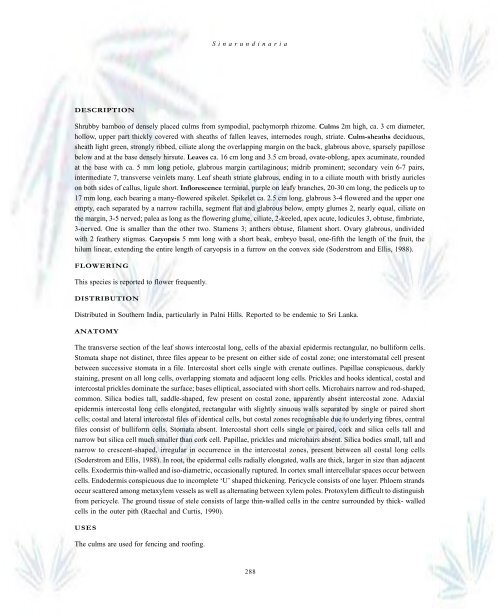Create successful ePaper yourself
Turn your PDF publications into a flip-book with our unique Google optimized e-Paper software.
Sinarundinaria<br />
DESCRIPTION<br />
Shrubby bamboo of densely placed culms from sympodial, pachymorph rhizome. Culms 2m high, ca. 3 cm diameter,<br />
hollow, upper part thickly covered with sheaths of fallen leaves, internodes rough, striate. Culm-sheaths deciduous,<br />
sheath light green, strongly ribbed, ciliate along the overlapping margin on the back, glabrous above, sparsely papillose<br />
below and at the base densely hirsute. Leaves ca. 16 cm long and 3.5 cm broad, ovate-oblong, apex acuminate, rounded<br />
at the base with ca. 5 mm long petiole, glabrous margin cartilaginous; midrib prominent; secondary vein 6-7 pairs,<br />
intermediate 7, transverse veinlets many. Leaf sheath striate glabrous, ending in to a ciliate mouth with bristly auricles<br />
on both sides of callus, ligule short. Inflorescence terminal, purple on leafy branches, 20-30 cm long, the pedicels up to<br />
17 mm long, each bearing a many-flowered spikelet. Spikelet ca. 2.5 cm long, glabrous 3-4 flowered and the upper one<br />
empty, each separated by a narrow rachilla, segment flat and glabrous below, empty glumes 2, nearly equal, ciliate on<br />
the margin, 3-5 nerved; palea as long as the flowering glume, ciliate, 2-keeled, apex acute, lodicules 3, obtuse, fimbriate,<br />
3-nerved. One is smaller than the other two. Stamens 3; anthers obtuse, filament short. Ovary glabrous, undivided<br />
with 2 feathery stigmas. Caryopsis 5 mm long with a short beak, embryo basal, one-fifth the length of the fruit, the<br />
hilum linear, extending the entire length of caryopsis in a furrow on the convex side (Soderstrom and Ellis, 1988).<br />
FLOWERING<br />
This species is reported to flower frequently.<br />
DISTRIBUTION<br />
Distributed in Southern India, particularly in Palni Hills. Reported to be endemic to Sri Lanka.<br />
ANATOMY<br />
The transverse section of the leaf shows intercostal long, cells of the abaxial epidermis rectangular, no bulliform cells.<br />
Stomata shape not distinct, three files appear to be present on either side of costal zone; one interstomatal cell present<br />
between successive stomata in a file. Intercostal short cells single with crenate outlines. Papillae conspicuous, darkly<br />
staining, present on all long cells, overlapping stomata and adjacent long cells. Prickles and hooks identical, costal and<br />
intercostal prickles dominate the surface; bases elliptical, associated with short cells. Microhairs narrow and rod-shaped,<br />
common. Silica bodies tall, saddle-shaped, few present on costal zone, apparently absent intercostal zone. Adaxial<br />
epidermis intercostal long cells elongated, rectangular with slightly sinuous walls separated by single or paired short<br />
cells; costal and lateral intercostal files of identical cells, but costal zones recognisable due to underlying fibres, central<br />
files consist of bulliform cells. Stomata absent. Intercostal short cells single or paired, cork and silica cells tall and<br />
narrow but silica cell much smaller than cork cell. Papillae, prickles and microhairs absent. Silica bodies small, tall and<br />
narrow to crescent-shaped, irregular in occurrence in the intercostal zones, present between all costal long cells<br />
(Soderstrom and Ellis, 1988). In root, the epidermal cells radially elongated, walls are thick, larger in size than adjacent<br />
cells. Exodermis thin-walled and iso-diametric, occasionally ruptured. In cortex small intercellular spaces occur between<br />
cells. Endodermis conspicuous due to incomplete ‘U’ shaped thickening. Pericycle consists of one layer. Phloem strands<br />
occur scattered among metaxylem vessels as well as alternating between xylem poles. Protoxylem difficult to distinguish<br />
from pericycle. The ground tissue of stele consists of large thin-walled cells in the centre surrounded by thick- walled<br />
cells in the outer pith (Raechal and Curtis, 1990).<br />
USES<br />
The culms are used for fencing and roofing.<br />
288


